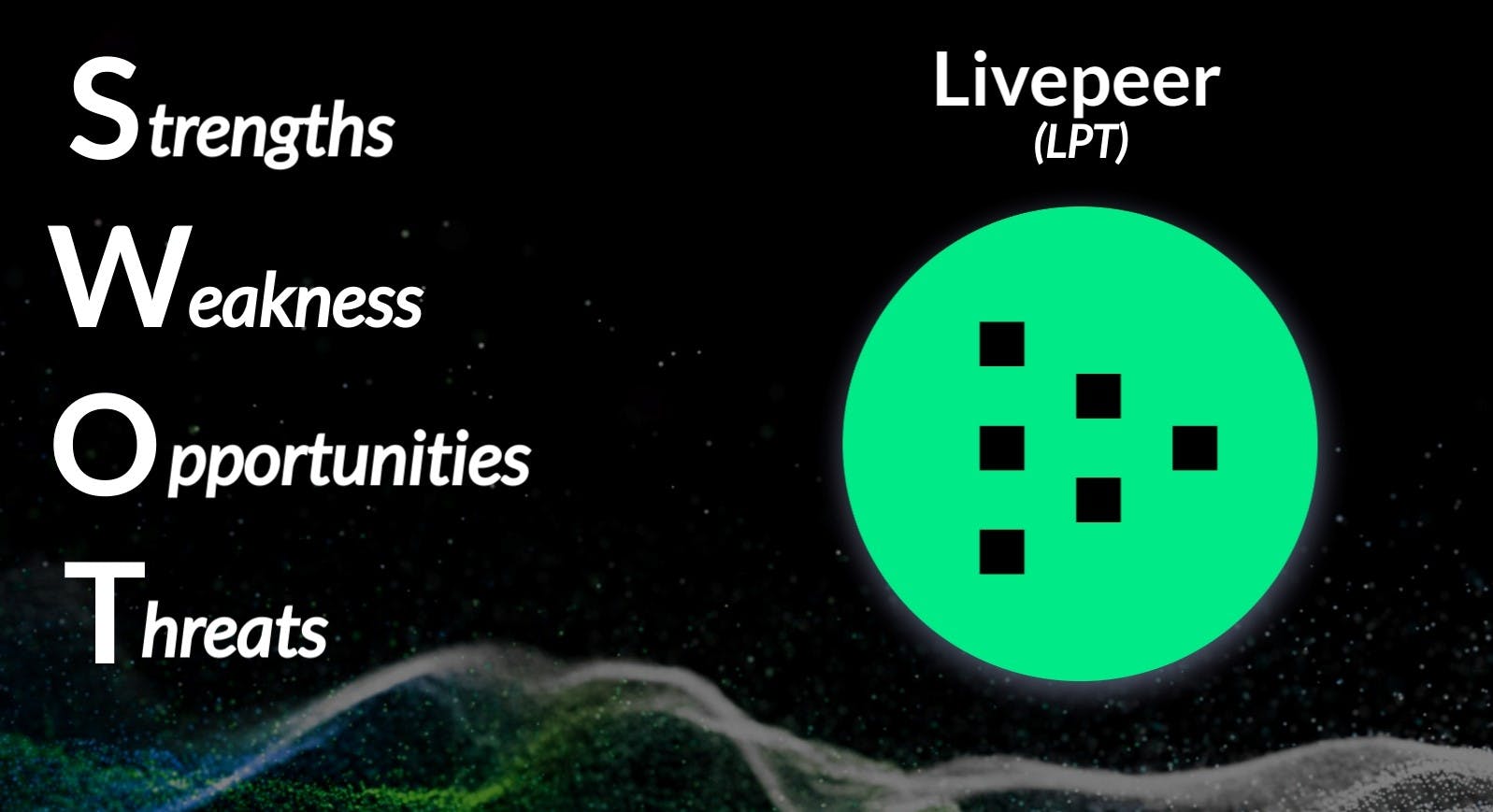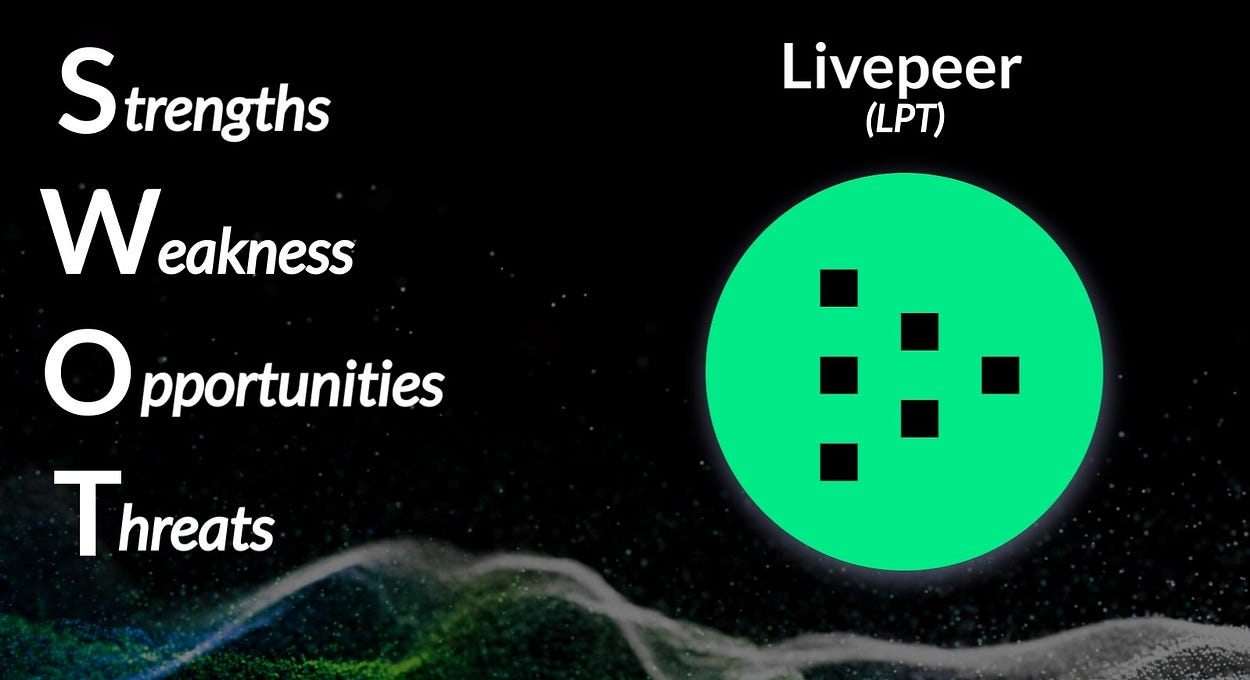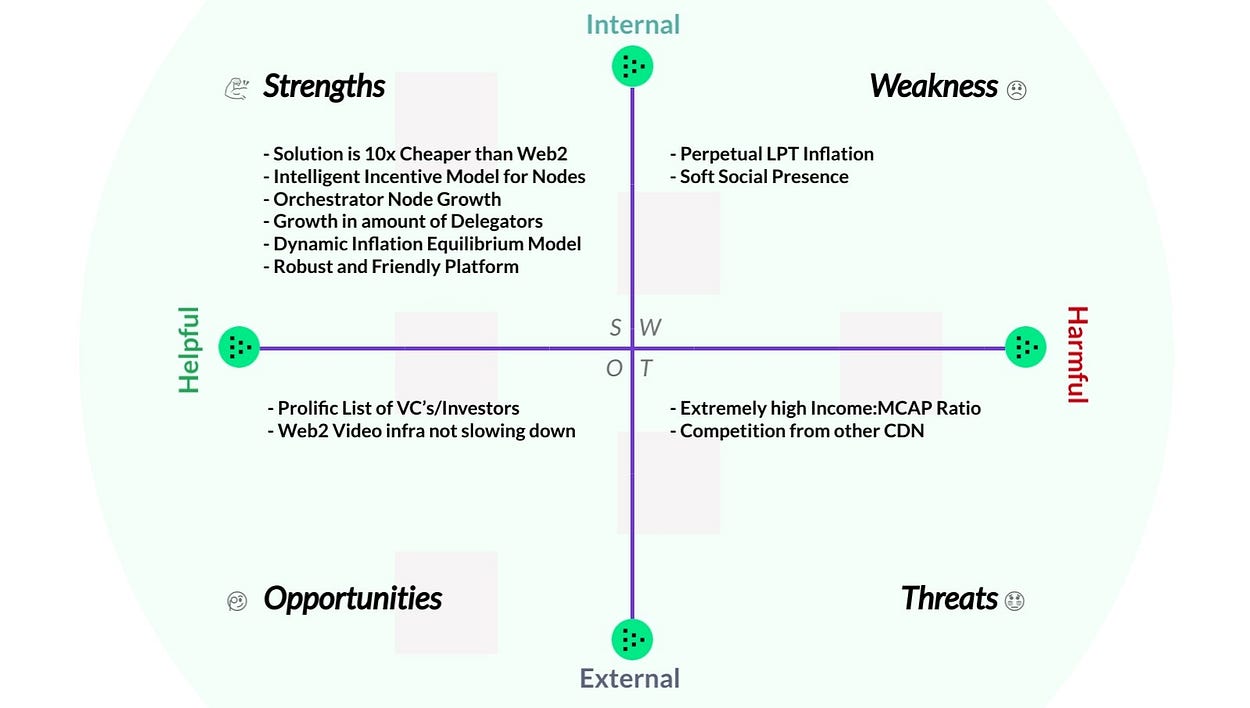
SWOT Analysis: Livepeer (LPT)
*Note, SWOT is an analysis of operational/fundamental elements. This is not a model to be used for technical or trading purposes. (NFA, DYOR)

Composed of four elements, Strengths, Weaknesses, Opportunities, and Threats, a SWOT analysis framework provides excellent insight for evaluating the state of a project’s well-being through the lens of a birds-eye view.
It can help formulate decisions on what areas require more attention, set performance goals, and organize a foundational understanding of where a project is headed.
Rarely (if ever) used in crypto, it is time to apply this timeless method of evaluation to the digital asset space.
Today, LivePeer (LPT), the video infrastructure CDN (Content Delivery Network) and transcoding marketplace provider in the decentralized economy, will get a SWOT.

💪 Strengths (Internal) (Helpful)
1. Solution is 10x Cheaper than Web2
At the core of Livepeer’s solution to video streaming is making streaming and transcoding an order of magnitude more affordable than traditional solutions that are currently on the market today. By bringing down operational costs so much, they are inviting a new caliber of entrepreneurs and creators into the media industry and potentially allowing for new creative business models to arise. By keeping operational costs low, they are positioned to inherit a new generation of users that otherwise cannot afford to pay the prohibitive costs associated with traditional Web 2 providers. While at this time they have already brought down the costs substantially, their ultimate vision is to reach a 50x cost reduction, which would likely create a moat for Livepeer; because at that level odds would likely be that nobody could compete with them.2. Intelligent Reward/Incentive Model for Nodes
Livepeer has two main types of participants on the supply side of the network, Orchestrators and Delegators. Orchestrators are the technical operator nodes that leverage physical devices to provide services and delegators are nodes that signal support for quality operators. In order to become an Orchestrator, users must stake LPT tokens. The more a node has at stake, the more “jobs” they can take, and in turn generate more revenue. The key here is that revenue is denominated in ETH or Stablecoins; providing sustainable real-yield income opportunities. While there is also an accompanying reward in the form of newly minted LPT that is attached to the income, the level at which this reward rate is set is minute and actually serves the function of increasing network ownership into the hands of the true contributors are reducing the influence of speculators and silent bystanders.3. Orchestrator Node Growth
Despite a difficult market environment, over the course of last year, the number of orchestrators more than doubled, increasing from 45 to 100. An increase in Orchastrators translates to an increased interest in the network from the side of providers which in turn translates to higher potential to support higher demands and brings with it a higher level of decentralization. Considering that the income/ demand side has not shown any increases, this might be foreshadowing expectancy of growth; which means a possible signal of a strengthing ecosystem.4. Growth in amount of Delegators
Support for the network has been shown by the general investor audience as can be seen through the year-on-year growth of ~17%. The number of delegators has increased from 3,500 to 4,100. While the some odd 600 new delegators are not necessarily huge; their growth during a bear market certainly is. Of course, this delegate growth also brings with it a higher rate of tokens that are taken out of circulation and locked into the securitization of the network.5. Dynamic Inflation Equilibrium Model
While typically I am not too big a fan of inflationary tokens, the inflation model Livepeer implemented reflects itself on the ecosystem in a generally positive way. Whenever the participation rate (the amount of delegated LPT relative to the total circulating supply) falls below 50% the inflation rate increases every “round” (5,760 Ethereum blocks / ~20.5 hrs) by 0.00005%; whenever the participation rate exceeds 50%, the inflation decreases by 0.00005% each round. Which means that over time, the mechanism autonomously balances out the saturation level of the participation rate.6. Robust and Friendly Platform
Livepeer does a phenomenal job providing comprehensive information on its products and tooling for every grade of user. Whether a total technical noob that has not yet developed an understanding of the industry or a prolific developer thats cloning DEXs every weekend and launching new projects for sport; Livepeer caters to both sides of the market. Be it in documentation, how-to guides, their awesome 10-minute primer, or the grant programs, there is a full suite of information readily available to present to the world. Moreover, the studio interface is so intutive that it deserves recognition for making Web3 rather familiar.
😞 Weaknesses (Internal) (Harmful)
1. Perpetual LPT Inflation
The LPT token has a perpetual inflation mechanism built in for reward distribution among stakers and workers. The two vector points might not necessarily generate excessive inflation but there is no cap on the total token supply; which in turn might reflect itself as a drag on the prices over the very long term. Fundamentally this does not damage the quality of the product that is provided nor should the low levels disincentivize new participants from joining, it is simply an economic factor that should be taken into consideration from the standpoint of speculators/investors/traders.2. Soft Social Presence
Relative to many other technologically advanced crypto infrastructure projects, Livepeer boasts a very modest ~36.9k user base on Twitter. When put into perspective on a side-by-side comparison with its closest competitor with an audience of over 267K users; they are roughly 8x behind. To be fair in this regard, they haven’t had the need to exert tremendous effort in this area at their current stage of development; they have been more focused on the actual technology.
🧐 Opportunities (External) (Helpful)
1. Prolific List of Renowned VC’s/Investors
Livepeer certainly has attracted support and financial backing from some of the industry’s more prominent names Coinbase Ventures, Digital Currency Group, CoinFund, and others. Interestingly enough, Livepeers vision has also drawn in investors/pools of capital that are not traditionally involved in crypto including; Tiger Global, Animal Ventures, Warburg Serres, and others.2. Web2 Video Infrastructure Showing no Signs of Slowing Down
Livepeer positioned itself to arbitrate out legacy infrastructure with the use of a decentralized network of transcoders. It seems as though legacy providers are not aware of their abusive pricing and have not exhibited any intentions of lowering their prices; arguably they are actually continuing to increase them. This trend plays perfectly into Livepeer’s mission and only strengthens their USP.
😳 Threats (External) (Harmful)
1. Extremely high Income:MCAP Ratio
For 2022, the Livepeer network generated $429,000 USD in revenue. Even when marked against today’s deflated (versus the mcap in 2022) marketcap of $135,000,000 that is a ratio of 314:1; meaning the token’s value is trading at 314x the value that the network produces. Granted, these dry valuation metrics (similar to a stock’s P/E ratio) are not perfectly applicable in the same way to Crypto; nonetheless, it’s something worth noting.2. Competition from other CDN
While the specific verticle of video-based CDNs is certainly not as saturated as other niches in the crypto industry, the level of competition here is pressured through qualitative measures. As is the case with Oracle networks, where there will likely be select, singular groups of projects that provide the vast majority of support to other projects, rendering new Oracles obsolete due to the inherent trust already established; Livepeers deep technical inclination forces it into a competition of winner takes all. The main project that they should be watching out for (or learning from) is Theta Network; the current industry leader for decentralized streaming
Takeaway:
Livepeer is a leader in the provision of decentralized video infrastructure for Web3. When taking into consideration its heavy focus on technology, a thorough understanding of its niche, well-designed tokenomic model, unique approach, and strong courting by financial backers, Livepeer is without a doubt an honest project solving real problems.
The Weaknesses are by no means debilitating and the threats are most likely not existentially dangerous, presenting a rather well-balanced risk-to-reward profile in terms of fundamentals.
Conclusion:
I have no exposure to Livepeer or any other CDN in my portfolio. To be totally honest, I am not well-versed in this category and have not spent any time researching the degree of issues that exist in the legacy video infrastructure world; so it is possible that I might have not addressed the full scope of technical wonder that VC’s and crypto funds might be able to understand.
For some odd reason, after spending a fair amount of time diving into as many resources on Livepeer as I could find, the silence (when measured against typical crypto infra projects that toot their horns and spend tens of thousands of dollars per day on brain-numbing banner advertising) gives me this sensation that LPT might be a potentially good play to make.
I will take a tiny, tiny portion maybe ~2% of my income and DCA into a mini-bag over the course of summer 2023. (this is not financial advice)
If you know something that I don’t or feel as though I might have missed anything worth noting, please do share, I would tremendously appreciate some feedback.
Thank you so much for reading,
I hope this serves you well on your journey.
Live long and prosper 🥂

